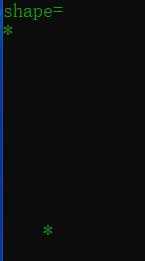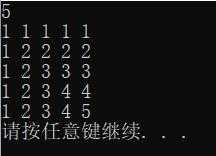标签:函数声明 字符 adr ++ shape 元素 技术 else lag
Part1
1.
#include <math.h> #include <stdio.h> #include <stdlib.h> void solve(double a, double b, double c); int main() { double a, b, c; printf("Enter a, b, c: "); while(scanf("%lf%lf%lf", &a, &b, &c)) { solve(a, b, c); printf("Enter a, b, c: "); } system("pause"); return 0; } void solve(double a, double b, double c) { double x1, x2; double delta, real, imag; if(a == 0) printf("not quadratic equation.\n"); else { delta = b*b - 4*a*c; if(delta >= 0) { x1 = (-b + sqrt(delta)) / (2*a); x2 = (-b - sqrt(delta)) / (2*a); printf("x1 = %f, x2 = %f\n", x1, x2); } else { real = -b/(2*a); imag = sqrt(-delta) / (2*a); printf("x1 = %f + %fi, x2 = %f - %fi\n", real, imag, real, imag); } } }
2.
#include <stdio.h> #include <stdlib.h> #include <windows.h> void printCircle(int x, int y); int main() { system("color 02"); printCircle(5, 10); Sleep(5000); system("cls"); printCircle(10, 5); system("pause"); return 0; } void printCircle(int x, int y) { int line, col; for(line = 1; line <= y-1; line++) printf("\n"); for(col = 1; col <= x-1; col++) printf(" "); printf("O"); printf("\n"); }
#include <stdio.h> #include <stdlib.h> #include <windows.h> void printCircle(int x, int y,char shape); char shape; int main() { printf("shape=\n"); scanf("%c",&shape); system("color 02"); printCircle(5, 10,shape); Sleep(5000); system("cls"); printCircle(10, 5,shape); system("pause"); return 0; } void printCircle(int x, int y,char shape) { int line, col; for(line = 1; line <= y-1; line++) printf("\n"); for(col = 1; col <= x-1; col++) printf(" "); printf("%c",shape); printf("\n"); return; }

Part2
1.
#include <stdio.h> #include <stdlib.h> #define N 1000 int fun(int n,int m,int bb[N]) { int i,j,k=0,flag; for(j=n;j<=m;j++) { flag=1; for(i=2;i<j;i++) if(j%i==0) { flag=0; break; } if(flag==1) bb[k++]=j; } return k; } int main(){ int n=0,m=0,i,k,bb[N]; scanf("%d",&n); scanf("%d",&m); for(i=0;i<m-n;i++) bb[i]=0; k=fun(n,m,bb); for(i=0;i<k;i++) printf("%4d",bb[i]); system("pause"); return 0; }

2.
#include<stdio.h> #include<stdlib.h> #define N 100 void fun(int x[N][N],int n) { int i,j; for(i=1;i<=n;i++) for(j=1;j<=n;j++) if(i<=j) x[i][j]=i; else x[i][j]=j; } int main() { int n,i,j,a[N][N]; scanf("%d",&n); fun(a,n); for(i=1;i<=n;i++) { for(j=1;j<=n;j++) printf("%d ",a[i][j]); printf("\n"); } system("pause"); return 0; }

3.
#include <stdio.h> #include <stdlib.h> void fun(int k,int bb[]) { int i; int j=0; for(i=1; i<=k; i++) { if(k%i==0&&i%2==0) bb[j++]=i; } for(i=j; i>=0; i--) printf("%d ",bb[i]); } int main() { int x, *t; scanf("%d", &x); t = (int *) malloc(sizeof(int)*x); fun(x,t); system("pause"); return 0; }

4.
#include <stdio.h> #include <stdlib.h> const int N=4; void output(char x[], int n); // 函数声明 // 排序函数声明 // 补足代码1 // 。。。 void turn(char a[],int n); int main() { char string[N] = {‘2‘,‘0‘,‘1‘,‘9‘}; int i; printf("排序前: \n"); output(string, N); // 调用排序函数对字符数组中的字符由大到小排序 // 补足代码2 // 。。。 turn(string,N); printf("\n排序后: \n"); output(string, N); printf("\n"); system("pause"); return 0; } // 函数定义 // 函数功能描述:输出包含有n个元素的字符数组元素 // 形参:字符数组,以及字符数组元素个数 void output(char x[], int n) { int i; for(i=0; i<N; i++) printf("%c", x[i]); } // 函数定义 // 函数功能描述:对一组字符由大到小排序 // 形参:字符数组,以及字符数组元素个数 // 补足代码3 // 。。。 void turn(char a[],int n){ int i,j,t; for(i=0;i<=n-2;i++){ for(j=0;j<=n-2-i;j++){ if(a[j]<a[j+1]){ t=a[j+1]; a[j+1]=a[j]; a[j]=t; } else{ a[j]=a[j]; a[j+1]=a[j+1]; } } } }

总结与体会
要注意边界条件,能否取等号,譬如Part2的第四题i小于n-1,j小于n-1-i,它们都不能取等号
标签:函数声明 字符 adr ++ shape 元素 技术 else lag
原文地址:https://www.cnblogs.com/msf66/p/11960810.html